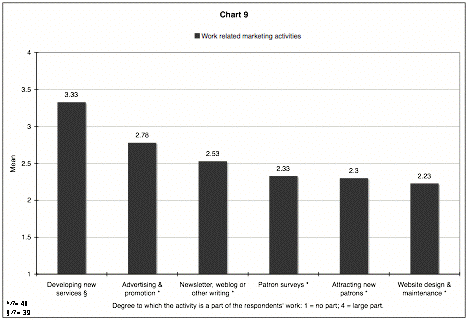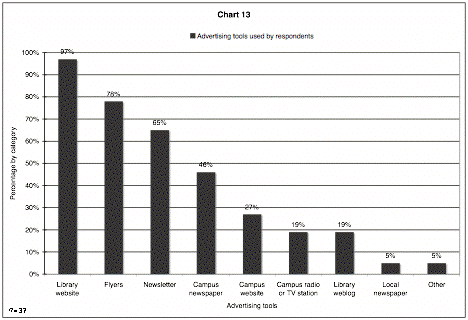


the nature of marketing (items 6, 7, 12, and 15)
knowledge of marketing techniques (items 2, 11, 26, and 27)
use of marketing techniques in an academic library (items 1, 5, 14, 17, 18, 21, and 25)
the need to market the academic library (items 8, 9, 10, 16, 19, 20, 22, and 23)
evaluating services and associated costs (items 3, 4, 13, and 24)








“We learned that our most underserved group were departmental secretaries, particularly those who are sent to do library work by faculty members.”
“We found that the library as a place leaves a lot to be desired.”
“Didn't really tell us much we didn't know through experience.”
“We made changes to library website based on student surveys.”
“Does libqual [sic] qualify as a marketing tool? If so, we have used the results of this survey to set some strategies in motion to improve student library worker attitudes especially.”
“We don't have a digital newsletter or library blog, but do have a decent webpage that we use. We also market a lot of new services in library instruction classes. We have a group called HILLGroup which works with teams consisting of a librarian, an ITS professional and a faculty member. That gets out a lot of info. about our library.”Chart 12


| Table 4 |
||
| Which of the following does your library routinely analyze? | ||
| Yes | No | |
| Search transaction logs | 33% | 67% |
| Circulation records | 85% | 15% |
| Other patron data | 54% | 46% |
| n
= 37 |
||
Theme-based scavenger hunts (using themes from the “Harry Potter” or “Lord of the Rings” novels).
Faculty meetings, in which a librarian with a laptop computer is available to answer questions or highlight specific resources, collections, or services.
Habitat for Humanity: librarians working together to build houses.
Display of senior honors theses.
“The library, the art department, and the English dept. co-ordinated to host a series of events in connection with national poetry month. The art dept. had a graphic design class use Natl poetry month as the topic for a poster assignment - and the library displayed the posters and hosted an opening. The English dept. scheduled a series of readings and the library hosted these events. The library also created a special display of poetry books and a "Post a Poem" bulletin board. All these events were advertised both inside and outside the library by posters, email, school & library website notices, and by vocal announcements.”
“We bring in all new faculty, introduce them to the realities and benefits of a small academic library (since most have just finished PhD programs at research institutions, this is a shock at first), pitch the value of library instruction, and finish with a wine and cheese party for all faculty in our Java City coffee bar.”
| Top |
Abstract |
Introduction | Method |
| Results | Discussion | Implications | Appendix
A |